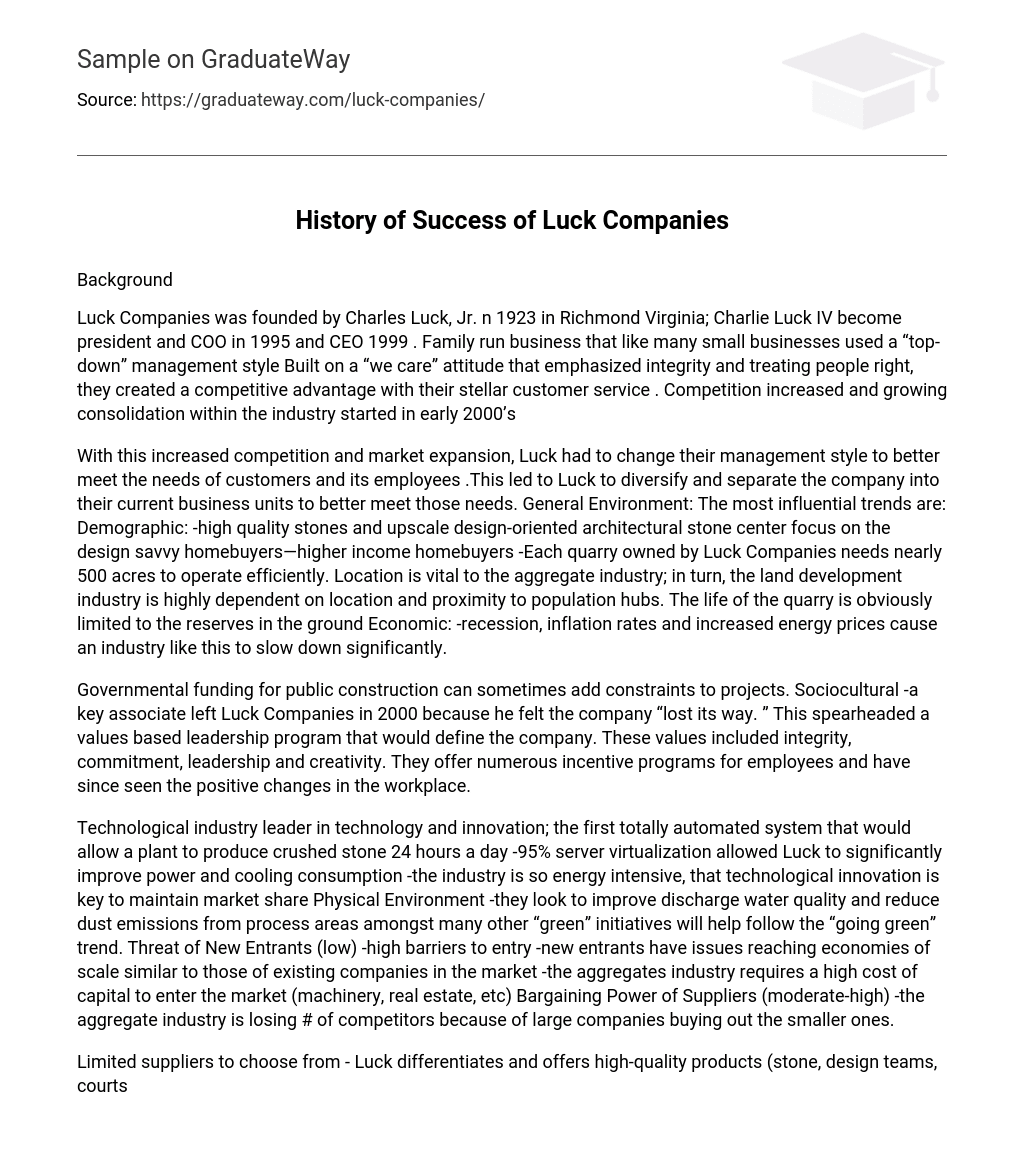Background
Luck Companies was founded by Charles Luck, Jr. n 1923 in Richmond Virginia; Charlie Luck IV become president and COO in 1995 and CEO 1999 . Family run business that like many small businesses used a “top-down” management style Built on a “we care” attitude that emphasized integrity and treating people right, they created a competitive advantage with their stellar customer service . Competition increased and growing consolidation within the industry started in early 2000’s
With this increased competition and market expansion, Luck had to change their management style to better meet the needs of customers and its employees .This led to Luck to diversify and separate the company into their current business units to better meet those needs. General Environment: The most influential trends are: Demographic: -high quality stones and upscale design-oriented architectural stone center focus on the design savvy homebuyers—higher income homebuyers -Each quarry owned by Luck Companies needs nearly 500 acres to operate efficiently. Location is vital to the aggregate industry; in turn, the land development industry is highly dependent on location and proximity to population hubs. The life of the quarry is obviously limited to the reserves in the ground Economic: -recession, inflation rates and increased energy prices cause an industry like this to slow down significantly.
Governmental funding for public construction can sometimes add constraints to projects. Sociocultural -a key associate left Luck Companies in 2000 because he felt the company “lost its way. ” This spearheaded a values based leadership program that would define the company. These values included integrity, commitment, leadership and creativity. They offer numerous incentive programs for employees and have since seen the positive changes in the workplace.
Technological industry leader in technology and innovation; the first totally automated system that would allow a plant to produce crushed stone 24 hours a day -95% server virtualization allowed Luck to significantly improve power and cooling consumption -the industry is so energy intensive, that technological innovation is key to maintain market share Physical Environment -they look to improve discharge water quality and reduce dust emissions from process areas amongst many other “green” initiatives will help follow the “going green” trend. Threat of New Entrants (low) -high barriers to entry -new entrants have issues reaching economies of scale similar to those of existing companies in the market -the aggregates industry requires a high cost of capital to enter the market (machinery, real estate, etc) Bargaining Power of Suppliers (moderate-high) -the aggregate industry is losing # of competitors because of large companies buying out the smaller ones.
Limited suppliers to choose from – Luck differentiates and offers high-quality products (stone, design teams, courts, etc) while the market share leaders use a low-cost leadership strategy. -Luck declined to lower their prices to Home Depot which eventually ended up in Home Depot switching to a competitor. Shortly thereafter, the competitor was unable to deliver as promised and Home Depot begged Luck to be their supplier at their price offering. Luck declined but gave them 120 days of ordering until Home Depot could find another supplier.
Bargaining Power of Buyers (low) – high switching costs -Luck’s differentiated products lowers buyer power Threat of Substitute Products (low) -customers are limited in the number of suppliers and products Rivarly among Competitors (moderate) although there are high exit barriers keeping companies active and rivalry intensive (governmental restrictions and specialized assets), the acquiring of smaller competitors by larger leave minimal number of competitors left in the industry -slow industry growth will increase rivalry among competitors Attractiveness of Industry=Low -we believe that because of the extremely high cost of capital to enter, governmental restrictions, differentiated products in the market and economies of scale that this is an unattractive to new entrants -because of the high exit barriers, threats involving the national economy, governmental restrictions that this is an unattractive industry





